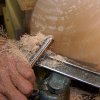Well, I agree with a lot of this, but have a few things to add.
There are a lot of cuts, primarily roughing cuts, done with either a gouge or a scraper which are safe to a certain degree, but can be catch prone if you are hanging out too far off the tool rest. It is a leverage thing, and we all do it. You know, getting that last bit off before moving the tool rest, and having the gouge or scraper start to chatter, then dig in. The wood and torque of the lathe can be too much if you don't have a long enough lever to support the amount of wood being taken off. Mechanical advantage to the turner when the tool rest is closer to the wood, and you have a longer heavier tool.
Another is biting off more than you can chew. This seems to happen more on uneven bowl blanks when first starting to rough them out. You have to nibble away at the rough areas before starting to really rough it out. If you just plunge in, you can get one of those uneven spots, and bam, you have much more steel on the wood than any lever can handle. This is much more of a problem on chainsawn blanks than on bandsawn blanks. This also can happen in the transition area on the inside of a bowl. You go from a thin cut on the wall, to a bigger cut in the transition. This is more of a problem with a big round scraper if you have a steep transition and you end up cutting on both the bottom of the bowl and the side at the same time. This same thing can also happen with a gouge if you have the whole nose of the gouge buried in the cut and the flutes are more up rather than on the side, pointing away from the inside of the bowl. More wood on the tool than any lever can handle. Also, the up hill side of the wings of the gouge will catch.
Another situation is on the inside of the bowl, when you get to the center. If you are pushing too hard, and go through the center, you hit the up side of the rotation, the tool, in contact with the wood goes up, and back around to the proper cutting side, and bam. Explosion, and damage to gouge and some times fingers as well. This some times happens when you are through with the cut to the center, and take your eyes off the tool as you lift it off the tool rest, and out of the inside of the bowl. The tip comes into contact with the spinning wood, and bam.
The primary roughing cut on a bowl, with a gouge, to me is a scraping cut. Flutes are held level, or with the handle held lower, or for me, I prefer a scraper. The cutting edge is pretty much at 90 degrees to the rotation of the wood. This can be done with the bevel rubbing, or not rubbing. The catching risk isn't from coming off the bevel, it is when the uphill wing of the gouge comes into contact with the wood. Lower side, no problem, mechanical advantage to the turner. Uphill side of the gouge, can be used, but it does make my sphincters pucker ("When sphincter tightening exceeds chuck tightening, you have a problem."--Pats Fan on Woodnet forums). I have seen Stewart Batty use this cut across the outside bottom of a bowl, no nose contact with the wood, just the wing, and like a skew, if you come off the bevel, you can get a catch. Rolling the gouge so the flutes are at 45 to 90 degrees to the rotation (10:30 to 9:00 o'clock) is much safer.
robo hippy


